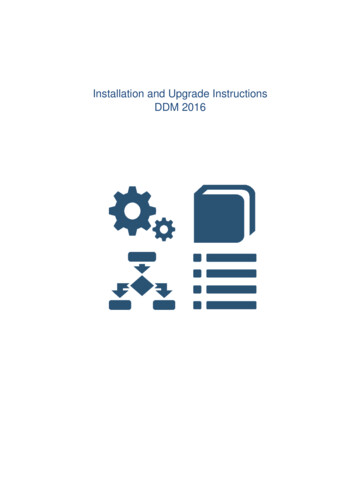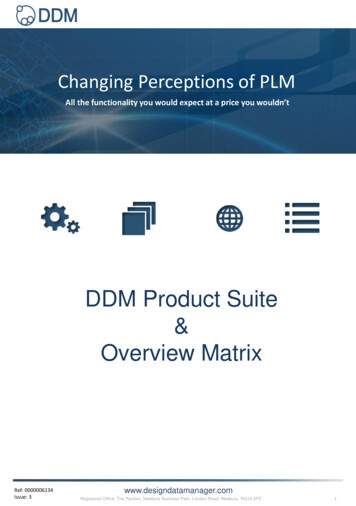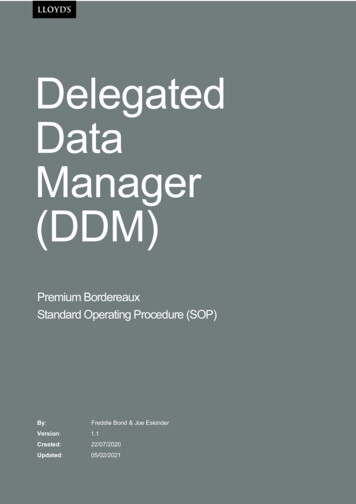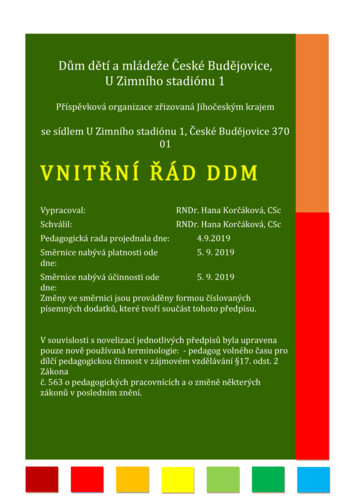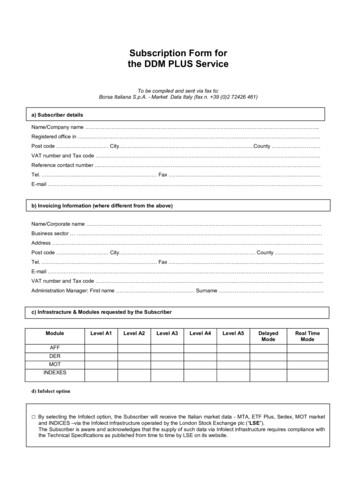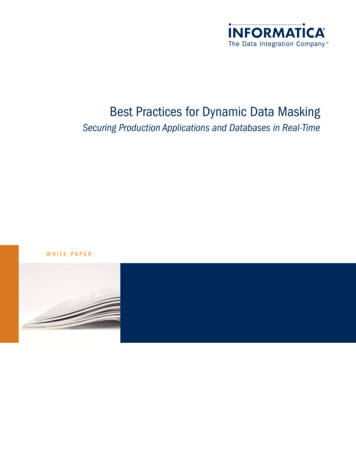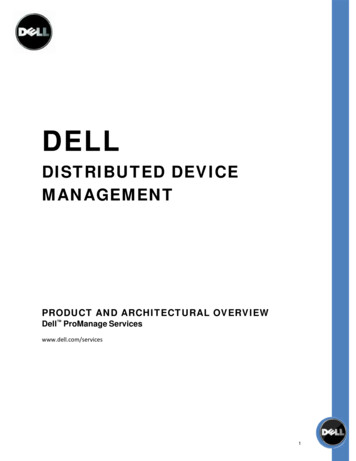
Transcription
DELLDISTRIBUTED DEVICEMANAGEMENTPRODUCT AND ARCHITECTURAL OVERVIEWDell ProManage Serviceswww.dell.com/services1
Table of ContentsKey Challenges for Managing Distributed Client PCs. 3Introduction . 3The Need for an Internet Based Platform. 4Dell Distributed Device Management Platform. 5Platform Specifics. 5Integration Framework . 6Device Agents. 7DDM Control Center . 9Customer and Partner APIs . 10Multi‐tenancy Infrastructure . 10Dell Distributed Device Management Services Overview . 11Service Features . 11Service Details ‐ FAQs . 13FAQ Dell Distributed Device Management (DDM) – General Service Information: . 13FAQ ‐ Asset Management – Service Details: . 20FAQ ‐ Software Distribution (and Removal) – Service Details: . 24FAQ : Anti‐Malware & Virus Management – Service Details . 31FAQ ‐ Dell Online Backup & Restore – Service Details: . 35Laptop Data Encryption – Service Details: . 42Summary . 472
Key Challenges for Managing Distributed Client PCsGlobal workforces, multi‐facility operations and the proliferation of mobile employees aremaking it increasingly difficult for organizations to track, manage and protect end user systems,especially those outside the corporate headquarters and the corporate network. For IT, thiscan lead to poor visibility into remote assets, less protection from security threats, complianceissues and difficulty in delivering a consistent level of service to end users. Key challenges for ITinclude:An increasingly mobile and distributed workforce – Users commonly work in multiplelocations and do not regularly connect to the company’s network (WAN/ LAN or VPN),making PC management difficult.The need to maintain an accurate inventory of PC assets – It is nearly impossible tosecurely manage PCs without knowing their location, what software is installed, patchhistory, remaining lease life, current user, and other critical data.Security and virus threats – The inability to adequately manage remote desktop protectionand security exposes a company to viruses, hackers and data loss.Compliance – Burdensome regulations such as Sarbanes‐Oxley, HIPAA and GLBA requirecompanies to maintain 24 x 7 visibility and control over their client PCs.As the number and complexity of distributed PCs has grown ‐ along with their value to theenterprise, it has become more imperative that these devices are operating correctly and incompliance with legal, regulatory, and contractual requirements. Maximizing the uptime andoverall usability of companies’ desktop and laptop assets through effective management andimproved security can have a significant and positive impact to employee productivity – and thebottom line.IntroductionThis paper provides an in‐depth look at Dell’s Distributed Device Management Platform andservice solutions for PC and desktop management. These solutions leverage the Internet toprovide efficient, cost effective services to simplify and automate IT tasks such as patchmanagement, software distribution, asset management, performing backups and more forremote and distributed environments. This paper also provides a detailed FAQ section whichprovides answers to specific questions about each of Dell’s services: Asset ManagementPatch ManagementSoftware DistributionAnti‐Malware & Virus ManagementOnline Backup & RestoreLaptop Data Encryption3
The Need for an Internet Based PlatformAccording to Gartner, properly managing their PC’s can save companies up to 1,900 per year on desktop PCs and up to 2,700 per year on laptop PCs.1The Internet has paved the way for a mobile, distributed workforce. The interconnectivity ofdistributed client PCs with the rest of corporate IT has been an essential element in the overallgrowth in productivity in the last decade. With that connectivity, however, comes avulnerability that poses two serious management problems for CIOs and IT management.The first challenge involves security for distributed PCs. The Internet is rife with viruses andother malware that can be a major source of downtime and potential data loss. Connectivityvia the Internet, though providing mobility and flexibility for the workforce, can also be a greatsource of vulnerability.Secondly, the Internet’s role as the common network for corporate devices complicates theirmanagement significantly. Traditionally, IT departments’ choices for solving IT problemsinvolving the Internet have been limited; IT could use the tool included with a given device aspart of their existing management suite, or deploy a new point solution for each of the myriadof IT problems faced (e.g. viruses, poor patch management, lack of effective backup), increasingtheir management challenge by adding yet another console to monitor.A centralized Internet‐based management platform is ideal for helping solve both of theseproblems. Typical solutions for managing individual, remote devices – particularly thosedeployed in the field – to a LAN or VPN‐based solution within the corporate network can bevery complex, as well as costly to deploy and manage. In addition, a true Internet‐basedmanagement platform integrates the best point solutions from multiple providers, freeing ITfrom the choice of “good enough” versus “too complex.”Dell’s Distributed Device Management (DDM) service is a centralized desktop management toolthat is built using an Internet‐based platform that delivers scalability for client PC managementto organizations of all sizes – whether they have 100 PCs or 100,000. Hosted by Dell anddelivered through the Internet, DDM services provide an integrated, hosted managementsolution for local and remote PCs. IT administrators can centrally track dispersed client assets,distribute software, manage patches and anti‐malware definitions, and enforce IT policies, suchas online backup and data encryption, for PCs located almost anywhere. Policy‐based,automated management helps eliminate the administrative burdens of manual managementsystems and provides bandwidth‐gated, granular control of your distributed devices. The1Gartner, “How to Reduce Your PC TCO 30% in 2011”, By Federica Troni, Brian Gammage, Michael A. Silver, March2009 (Table 3 – Estimated savings by moving from unmanaged desktops and travelling worker notebooks to wellmanaged ones).4
services can be deployed under multiple options – PCs can be managed solely by anorganization’s own IT department using the DDM platform, remotely by Dell or managed usinga combination of services and options that best fits the your organization’s IT resources.Dell Distributed Device Management PlatformPlatform SpecificsDell’s Distributed Device Management Platform provides three common functions that can beused by any application on the DDM Platform or that is part of a partner offering. Thesefunctions are exposed through the DDM Control Center, a single window into the environmentof all managed devices. The three functions are as follows:Analytics – This function supports standard reporting and analysis across device data,financial data, and application data gathered from applications integrated into theintegration framework.User Management – This function allows administrators to maintain user roles,permissions, and the list of services that users are allowed to access.Security – This function supports security for sign on, user access, and encryption ofcommunications between the device being managed and the DDM data centers.Each of the above functions can be applied to any of the data or operations of applicationsrunning on the DDM Platform and all these functions further support DDM’s plug‐and‐playrequirement. In addition, the analytics capability allows the DDM platform to function as abusiness intelligence platform for the delivery of reports and other analytics.Dell Distributed Device Management Platform has five main components: Integration Framework Device Agents DDM Control Center Customer and Partner APIs Multi‐tenancy Infrastructure5
Figure 1 DDM Platform Architecture**Note: Client PC data for the DDM Online Backup & Restore service is backed up to and restored from data centers of Dell Partner Iron Mountain.Integration FrameworkThe Integration Framework is a combination of web‐services and device‐resident command lineAPIs that supports the integration of software applications and other functional componentsthat deliver management services or provide functionality to the devices supported by DDM.These applications also make use of DDM Device Agents (see below).Applications running in the Integration Framework can be delivered via an on‐demand model aspart of Dell’s DDM services or as part of a third‐party service provider offering. Dell DDMPlatform currently supports services including Dell Asset Management, Dell SoftwareDistribution, Dell Patch Management, Dell Anti‐ Malware & Virus Management, Dell OnlineBackup & Restore, Dell Laptop Data Encryption, as well as provides remote support. Dell is inthe process of opening the Integration Framework to allow virtually any application to beintegrated into the DDM Platform in a plug‐and‐play manner.6
The platform also supports Permissions Management as well as Service EntitlementManagement functions, both of which can be used by Dell partners and independent servicevendors. Permissions Management allows user access to applications running on the platformto be managed according to users’ specific roles and the permissions associated with thoseroles. Similarly, Service Entitlement Management allows applications running on the platformto deliver functionality based on varying levels of service. This allows Dell and Dell’s servicespartners to control service delivery and costs based on the actual services contracted by anindividual customer or user organization.The Integration Framework allows Dell to deliver a plug‐and‐play environment that is extensibleto the greatest possible range of devices and management solutions.Device AgentsDevice agents must be deployed on every device DDM manages and provide the directconnection – via the Internet – between the device and DDM Platform. Agents are alsodesigned as open platforms that can run either the basic asset management service DDMprovides or additional desktop management services powered by applications from Dell orDell’s partners.The device agents provide extensible mechanisms for software download, inventory gathering,logging, and diagnostics. The information collected from the device agents integrates throughthe Integration Framework and is made accessible to applications running on the platform.The Device Agents extend the openness, extensibility, and scalability of the IntegrationFramework directly to the client PCs to be managed. This further supports Dell’s goal to makeDDM Platform plug‐and‐play and makes it possible for the DDM Platform to support virtuallyany Internet‐connected device. The ability to deploy these Device Agents to any Internet‐awaredevice enables Dell to provide network‐neutral deployment architecture for the DDM Platform.7
Table 1: Communications Between the Managed Device and the DDM Data CenterDDM ServiceAll DDM ServicesData BeingTransferredAgent heartbeatDDM – AssetManagementDevice hardwareand basic softwareDDM – SoftwareDistributionApplication beingdistributedDDM – PatchDistributionDDM – Anti‐Malware & VirusManagementDDM – Anti‐Malware & VirusManagementDDM – Anti‐Malware & VirusManagementPatch beingdistributedFrom ‐ ToTransfer IntervalProtocolPortDevice to DDMData CenterDevice to DDMData CenterDDM DataCenter or RelayServer toDeviceDDM DataCenter or RelayServer toDeviceEvery 15 minutesfor each deviceOnce a day for eachdevicehttps /SSL Encryptedhttps /SSL EncryptedBased ondistribution policyset by IThttps /SSL Encrypted443Based ondistribution policyset by IThttps /SSL Encrypted443443443Virus definitioncheck/updateDDM DataCenter toDeviceEvery hour for eachdevicehttps /SSL Encrypted443Firewall policysetupDDM DataCenter toDeviceBased on policysetup and/orchange by IThttps /SSL Encrypted443Every three hoursfor each devicehttps /SSL Encrypted443Every 24 hoursand/or manually atany time initiated byend user or IThttps / 128‐bitAdvancedEncryptionStandard (AES)https / 128‐bitAdvancedEncryptionStandard (AES)Firewall policycheck/resetDDM – OnlineBackup & RestoreHard drive backupDDM – OnlineBackup & RestoreData restoreDDM DataCenter toDeviceDevice toDDM/IronMountain DataCenterDDM/IronMountain DataCenter toDeviceManually at anytime initiated byend user or IT1638416384DDM – LaptopData EncryptionInstruction todelete encryptionkeyDDM DataCenter toDeviceAutomatically basedon policy ormanually if device isreported lost to Dellhttps /SSL Encrypted443DDM – LaptopData EncryptionInstruction torestore encryptionkeyDDM DataCenter toDeviceManually by Dell ifdevice is foundhttps /SSL Encrypted4438
DDM Control CenterThe DDM Control Center provides a single Web‐based window into the environment of alldevices that are by a given company. Administrators can access the DDM Control Center overthe Internet and can get an up to date view of all managed devices and perform any authorizedtasks – from distributing software upgrades or the latest security patches to updating antivirusdefinition files to running a report on device that have not connected to the Internet for aspecific period of time. The DDM Control Center has a number of features that makes it easyfor IT to administer all devices under management:Web 2.0 User Interface (AJAX based) – Customizable dashboard driven user interface withdrag and drop capabilities, customizable grids, multi‐select rows, right click, clipboard, andclient like interactionsWidgets – Multiple actionable widgets – can click on widget to directly go to data – enablepersonalized home pagesReporting – Nearly 60 reports and chartsQuery and Search – Advanced query tool with both Boolean and full text searchFigure 2: Monitoring Devices with the DDM Control Center9
Customer and Partner APIsThe DDM platform can provide external‐facing data retrieval APIs that enables Dell’s partnersand third parties to extract data from the DDM Platform and its applications. This data can beused in internal reporting, application integration and other functions, enabling DDM to provideextensibility and plug‐and‐play support based on an open Web Services model. Document APIswill be provided by Dell in late 2009.Virtually any programming environment can be used to access these interfaces, including Java,C#, Perl, or C . Dell will continue to extend the nature and quantity of API’s available inupcoming releases of DDM.The customer‐facing APIs will enable Dell to integrate existing data regarding users, applicationsand other information that may be needed by an application running in the IntegrationFramework. This allows Dell to not only make use of existing directory data for devicemanagement, but it also enables DDM customers to run internal applications alongside theDDM platform, allowing deployment of hybrid systems that mix cloud‐delivered and on‐premise functionality – for example, integrating DDM data with an on‐premise service deskticketing solution.The partner‐facing APIs will perform a similar role. Partner service providers can link theirexisting on‐premise or managed solutions, such as customer relationship management andserver management, directly to the DDM platform. This enables them to deliver solutions ontop of the DDM services provided by Dell.Multi-tenancy InfrastructureFinally, the Dell DDM Platform is based on a multi‐tenancy architecture that vastly simplifiesimplementation and services costs. This allows Dell and Dell’s partners to deliver devicemanagement services that are highly functional while remaining very cost effective. Theredundancy and failover capabilities built into the DDM platform enable Dell to meet its criteriafor built‐in failover.10
Dell Distributed Device Management Services OverviewService FeaturesDell Distributed Device Management Platform Provides a single “window” into PCs located anywhere on the Internet.Provides an intuitive, easy‐to‐use web interface. Allows for customized branding forpartners, VARS, or customers.Dell Asset Management Service – automatically discover, inventory and track distributeddesktops and notebooks. Track warranty information, cost, and lease information.Help enforce enterprise, standard use policies.Evaluate assets for hardware refresh or upgrades.Dell Software Distribution Service – distribute and control software and versioning. Enable policy‐based management to maintain PCs by type or use, not one‐by‐oneHelp enforce software compliance; track and report on all software distributionsAutomate complex deployments using intelligent software‐installer compatibilitycapabilitiesDell Patch Management Service – automate and centralize patch management processes formajor vendors including Microsoft (Windows, Vista and Office) Adobe , VMware and Apple and over 500 applications. Customer‐defined policies to automate deployment and patch management analysisPolicy‐based bandwidth management and historical reporting.Dell Does IT For You option availableDell Anti‐Malware & Virus Management Service – remotely install and control virus andmalware updates for Symantec and McAfee software for distributed PCs. Centrally install files and upgrades without user involvement – whenever the userconnects to the InternetIdentify and monitor virus and malware infectionsRelieves IT from the complex tasks of configuring and maintaining on premise serverand management console from anti‐malware vendorsDell Does IT For You option available11
Dell Online Backup & Restore Service – automatically back up data from desktops and laptopsto an off‐site top‐tier datacenter providing an accurate, secure and worry‐free data store. Eliminates dependence on end users –Backups are run automatically without end‐useractionDoes not require corporate network connectivity –Only an Internet connection isrequired to back up or retrieve data (no WAN/ LAN or VPN required).Centralized management and reporting console (integrated with Dell Distributed DeviceManagement service) enables identifying non‐compliant PCs and initiating backups.Minimize network and end‐user impact – Data compression, backup of only incrementalchanges, check‐point restart and other policies minimize impact.Dell Laptop Data Encryption Service – protects all data on an organization’s laptops/PCs byencrypting all data to ensure that only authorized users have access. Designed to protect all data –All end‐user data on a protected PC is encrypted andremains secure even when a laptop is lost or stolen.Fully managed, hosted service –Dell hosts and manages the service –no infrastructure ormanagement costs. Centrally manage security policy –Deploy encryption on remote PCs.Encryption keys are automatically destroyed by predefined policies and can be centrallyrestored as needed.Intelligent data encryption –Locates and encrypts all data files residing on a hard drive,without encrypting the OS or application files, providing the same benefits of full diskencryptions solutions without the negative impact on PC performance generally seenwith the full disk encryption solutions.Automated encryption –All data files on a PC are encrypted without any input orinvolvement by end users, effectively eliminating any security issues due to user errors.Pre‐set protection policies –Encryption key is eliminated and data is made inaccessibleunder policy driven, specific pre‐set conditions including password hack, hard driveremoval, reported theft or failure to connect over a pre‐set period.Remote data restoration –Data on a lost or stolen PC can be remotely restored by Dell ifthe PC is ultimately recoveredHelp with recovery of stolen PCs –Dell can provide information on lost devices usingnetwork traces, network configuration data, and user activity.Fully Managed Desktop Services – You also have the option of having Dell remotely manageyour entire desktop environment for you using the Distributed Device Management Platform,providing Service Desk, onsite Field Service, Asset, Patch and Anti‐Malware & VirusManagement, along with additional services of your choosing.12
Service Details FAQsFAQ Dell Distributed Device Management (DDM) – General Service Information:1. How does the DDM Service work?An agent, running as a service, is installed upon devices that are to be managed. This agentthen orchestrates a number of silent operations including hardware inventorying andcoordinating upload/ download of configurations and information.2. Can DDM Services be sold a la carte?Yes. DDM Services can be purchased a la carte or part of a bundle of services. Dell highlyrecommends a customer purchase the Asset Management service along with any other a lacarte service.3. If I purchase a DDM Service a la carte, can I purchase and install additional services at alater date?Each DDM Service provides the administrator with ability to easily layer services at a laterdate. Once the Dell DDM Agent has been installed on a device and a customer haspurchased the additional service, the DDM Control Center will dynamically provide theadditional functionality and make available all necessary installation media to the customervia the console.4. How are DDM Services priced?Each DDM Service is priced on a per‐seat, per‐month model and can be billed monthly orannually.5. What is the annual maintenance fee for DDM Services?There are no annual maintenance fees for DDM Services. DDM is delivered using the SaaS(Software as a Service) model; it is delivered remotely and paid for monthly on asubscription‐like basis. Updates are automatically applied to the DDM Control Center andunderlying services with no end user or IT administrator interactions.6. How will service updates to the DDM client be made?Enhancements and fixes are applied automatically by the Dell team. No IT administrator orend user involvement is necessary.13
DDM – Deployment:7. How long does it take to provision a DDM Service?Once purchased, the process of configuring the DDM Control Center and creating aninstaller takes no more than thirty minutes.8. How do I retrieve the DDM Service installer?The Agent Installer is hosted within the DDM Control Center and is easily downloaded froma unique URL.9. How is a DDM Service deployed?There are several methods for deploying a service. The simplest way is to double click onthe Agent Installer. In larger deployments, login scripts can be used or Dell’s Asset Discoveryfrom the DDM Control Center can be utilized to identify and target computers forinstallation.10. Where do DDM Services install?The services install to: specified drive :/svctools.11. How does DDM uniquely identify a computer?When the Agent Installer is executed, it communicates with the DDM Control Center andrequests a subscription id (Asset Number) from the Control Center. It is this value that isused to uniquely identify a computer and ensure proper communication.12. Can I install DDM on a drive other than “c:”?Yes.13. How does a DDM Service get installed if the end user is not a local administrator?If the end user does not have the local permission to add software, Dell has a solution calledDomain Administrator Impersonation that can help. A user has the ability to utilize a “run‐as” function that will execute the installer automatically utilizing credentials that allow forsoftware installation. This means that the end user’s permissions never need to be adjustedand deployment can continue silently and without interference.14. Can I integrate DDM Services with Active Directory?Not at this time. DDM doe have the ability to query Active Directory servers and retrieveuser information and sync the data to managed devices. Dell understands that integrationwith Active Directory is a key request and is working towards a solution in a future release.14
15. What is necessary to deploy a DDM Service?The essential requirements necessary to deploy DDM are Internet connectivity and aWindows operating system on the device(s) that will be managed by DDM.16. How long does installation execution take? Is a reboot required during installation?The installation of the Agent typically takes no more than 15 minutes. The installation canbe configured to occur silently with no end user interaction whatsoever or to include aRegistration page that asks the user to enter in their contact information. In both cases, noreboot is required when installing the Dell Agent.17. Can I change the polling frequency of the DDM Agent?No. Currently the Dell Agent is configured to make an outbound heartbeat on 15 minuteintervals.18. What are the installation requirements for DDM Agent on a client device?The device must have a Windows Operating System, Internet connectivity at the time ofinstall, and the individual executing the installer must have sufficient permissions to installsoftware on the device (if Domain Administrator Impersonation was configured, the lastrequirement is met). Different DDM services have different minimum Windows Systemsrequirements. The following table provides minimum system requirements for each DDMservice:15
Table 2: Operating Systems Supported by DDM Agent and DDM Services:Service NameOperating SystemWindows 2000 SP3, SP4 Workstation, Windows 2000 Server Core DDM AgentAnti‐MalwareManagementAntivirus – McAfee Security 8.5Antivirus –Symantec 10.1Antivirus ‐ Symantec10.2Antivirus ‐ Symantec11Laptop DataEncryptionDevice Discovery(Host)LAN‐Based remotecontrolOnline Backup andResetPatch ManagementSP4, Windows XP SP1, SP2, SP3, Widows 2003 OEM, SP1, SP2,Windows Vista SP1, SP2Windows 2000 SP4 Workstation, Windows 2000 Server SP4,Windows XP SP2, SP3, Windows 2003 OEM, SP1, SP2, WindowsVista SP1, SP2Windows 2000 SP3, SP4 Workstation, Windows 2000 Server SP4,Windows XP SP1, SP2, SP3, Windows 2003 OEM, SP1, SP2, WindowsVista SP1, SP2Windows 2000 SP4 Workstation, Windows 2000 Server SP4,Windows XP SP1, SP2, SP3, Windows 2003 OEM, SP1, SP2Windows Vista SP1, SP2Windows 2000 SP4 Workstation, Windows 2000 Server SP4,Windows XP SP1, SP2, SP3, Windows 2003 OEM, SP1, SP2, WindowsVista SP1, SP2Windows 2000 SP4 Workstation, Windows XP SP2, SP3, WindowsVISTA SP1Windows 2000 SP3, SP4 Workstation, Windows 2000 Server SP4,Windows XP SP1,SP2 ,SP3, Windows 2003 OEM, SP1, SP2, WindowsVista SP1, SP2Windows 2000 SP3, SP4 Workstation, Windows 2000 Server SP4,Windows XP SP2, SP3, Windows 2003 OEM, SP1,SP2Windows 2000 SP4 Workstation, Windows XP SP1, SP2, SP3,Windows Vista SP1, SP2Windows 2000 SP3, SP4 Workstation, Windows 2000 Server SP4,Windows XP SP1, SP2, SP3, Windows 2003 SP1, SP2, Windows VistaSP1, SP2Windows, Windows Vista, Windows 2000 – 2007, Windows XP and Workstation are all registered trademarks of the MicrosoftCorporation.16
19. How much hard drive space is required to install the DDM client service?It is recommended to that the device has at least 50 MB of free space.20. What operating systems are supported by the DDM client service?At this time, operating systems for Windows 2000 through Vista are supported. Pleasesee the chart above for more details. Support for Windows 7 OS is expected in late 2009.21. Is the service available for non‐Windows OS’s like RedHat linux?Only Windows operating systems are supported at this time. Dell plans to have support fordevices running on Mac OS X 10.5 and higher in early 2010.22. How do I export data out of the DDM Control Center and into productivity software(Microsoft Excel Microsoft Access , SQL Server )?Nearly every page within the Control Center has an “Export to Excel” option that places thedisplayed data into an Excel spreadsheet on the user’s computer. Additionally, with theplanned release of documented API’s in October 2009, DDM will enable transfer of datafrom DDM to other applications.23. How much RAM is required to install the DDM client service?At least 32 MB of RAM is required to install DDM Services.24. How large is
DDM Platform plug‐and‐play and makes it possible for the DDM Platform to support virtually any Internet‐connected device. The ability to deploy these Device Agents to any Internet‐aware device enables Dell to provide network‐neutral deployment architecture for the DDM Platform.
